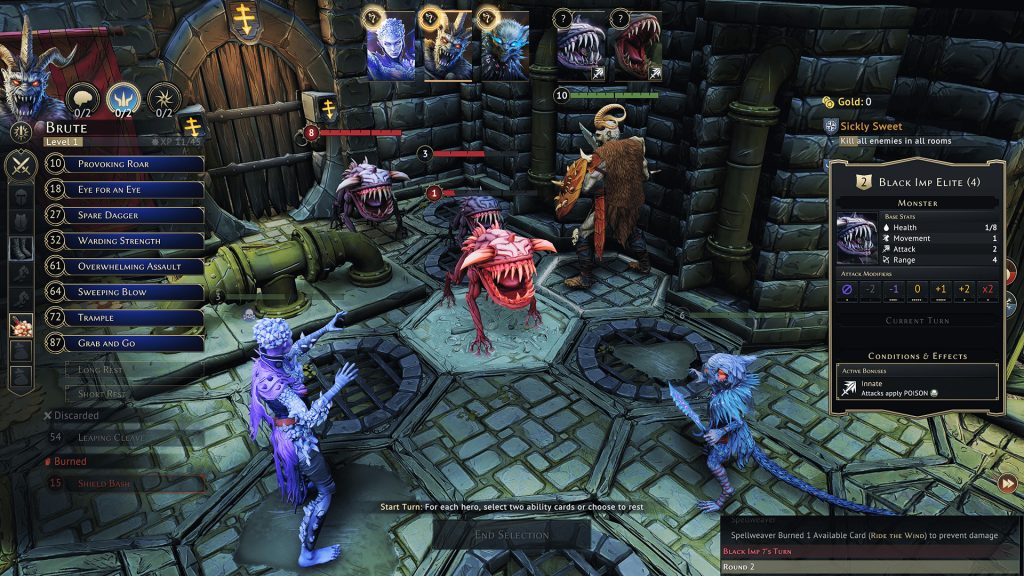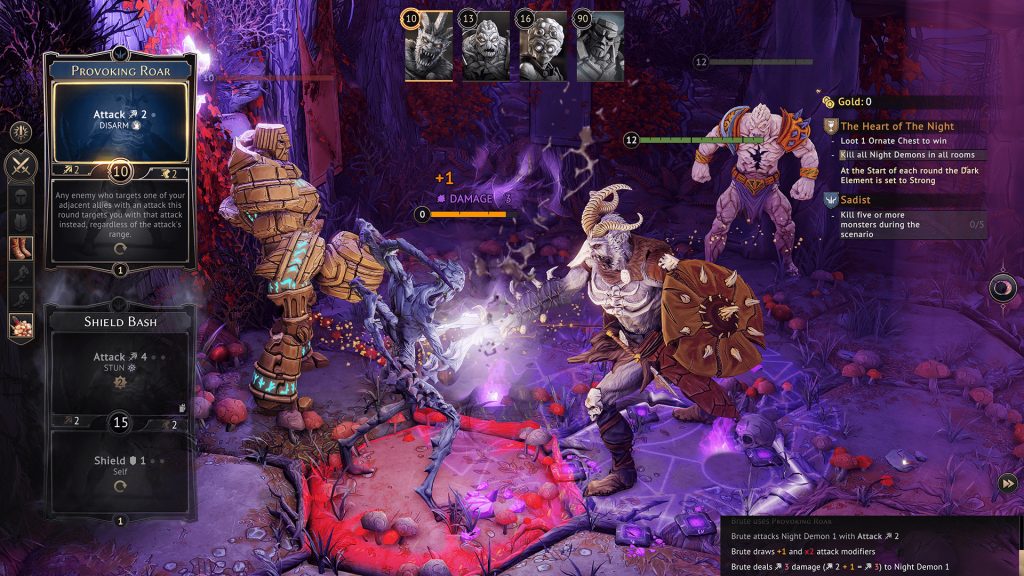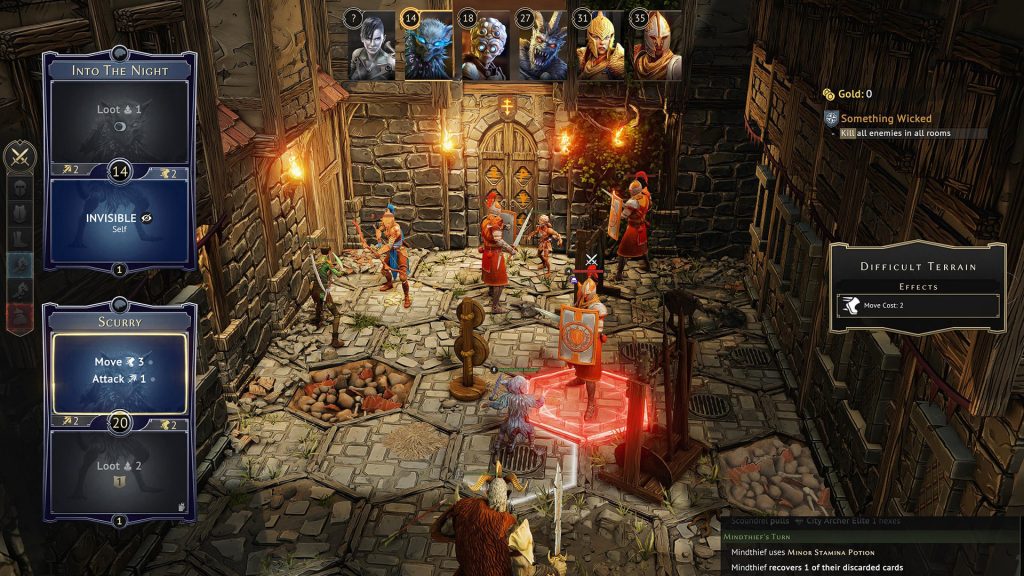The brainchild board game of Isaac Childres, Gloomhaven, is now available digitally on PC & Mac, via Steam and GOG. We have been lucky enough to get our hands on this turn based tactical experience in both mediums, originally as a board game and now in video game form – from Flaming Fowl Studios and Asmodee Digital. Gloomhaven is a campaign experience where 2 – 4 mercenaries journey through dungeons, battle past countless enemies and hope to get rich. Playable solo or cooperatively, players will overtime level up their chosen character, evolve their deck and use cards to overcome tactical battles. However, is this adaptation worthy of the original’s grandeur? Let’s find out!
Gloomhaven includes 17 unique mercenary characters to choose from, with players able to create a party from six of the roster at the start of the game. Each character has their own deck of cards, giving them unique abilities and playstyles. Starting out in the city of Gloomhaven mercenaries will party up and have the opportunity to splash some coins at the market. A small range of items is initially available, each buffing a character in a different way – from adding stuns to their attack to having the ability to lessen damage taken.
There are encounters and events of sorts, triggered when moving along roads or returning to the main city, though most of Gloomhaven revolves around completing missions. By travelling to denoted locations on the world map players will attempt these missions. Missions are the core of the game, coming with small short term goals for each mercenary, an overall mission objective, enemies to overcome and potentially loot to obtain.
Missions are small skirmishes with the objective often to progress through the rooms of the cave, crypt or forest killing off the enemies. Drawing from the likes of Dungeons & Dragons there’s initiative, with players and enemies taking a turn when it gets to them in the order. However, in Gloomhaven players utilize their character’s deck of cards to choose what to do and determine their initiative each round.

At the start of each round the players choose 2 cards each from their hand. Each card features a top action, a bottom action and an initiative value. Whichever card the player chooses as their leading card determines their position in the initiative order. The actions can be melee attacks, ranged attacks, movement, special abilities such as pushing enemies and much more. From the two cards played the player will choose one to activate the top action and one to activate the bottom action.
Importantly, this choice is only made when it’s the players turn in the initiative order, so there is some flexibility. Furthering this flexibility, there are basic actions. A top action can be always taken as a 2 strength attack, whilst a bottom action can be used instead for a 2 movement. These are much less fancy but mean a card can often be used for at least some benefit.
Attacks always have a strength, though some will come with a range, an area of effect and others will include elemental upgrades. Some actions will cause elements to be evoked, and for the next two turns players can spend the denoted element if their action allows it to either buff it or add an additional power. When the target or targets are selected, the attack is actioned.
For each attack a modifier is drawn. This comes from the player’s modifier deck, which as the player levels up can be slightly customised. The majority of these cards will either +1, +0 or -1 to the attack strength, however there are also a x2 and a critical miss in each deck. This is almost random, though the deck is reset when specific cards, such as the critical miss, are drawn.

The deck isn’t just how players deal out damage and move around the hexagonal grids of locations. Players’ decks are also how the game measures stamina. When played cards will be either discarded or burnt. Burnt cards can rarely be regained, unlike discarded cards which are mostly reclaimed by resting. There is a real choice to resting. Short rests allow you to gain cards back and still have a turn that round; the catch is a random discarded card is lost. Long rests take your entire turn that round, however you choose which of your discarded cards to lose. When a player can no longer play two cards or rest on their turn they become exhausted.
The party will be journeying across over 160 missions, gaining experience, purchasing gear and even seeing characters retire along the way. To complete a mission the party must fulfill its objective, with at least one mercenary still unexhausted and just as importantly not knocked out from their health hitting zero. Mercenaries will visit locations all across the world map, often venturing far from the city of Gloomhaven. By completing missions and events, new mission locations will appear and before long players get to choose from a range of available missions. This is where the story of Gloomhaven wraps the players up and then they are on the narrative journey, full of puzzle-like mission encounters to overcome.
In our review of the board game version of Gloomhaven one of our biggest negatives was the admin. From the lengthy setup time, activating each enemy and tracking health, elements tokens and more, there was a lot stopping the game hitting the table quickly and the gameplay from flowing when it was there. Combine this with needing to remember the rules of how to activate enemies and with the game’s AI handling all of this, players are free to just play and enjoy.
Coming from the background of holding the cards, or on TableTop Simulator where they are along the bottom of the screen, the vertical list of playable cards is at first detrimental. It’s harder to flick through them, hovering over each individually to see what they do. Over time though, as players get used to their deck, it becomes an improvement – costing less real estate on the screen and letting the 3D environments of the game shine.

Every mercenary and enemy type are distinctive. With plenty of detailing, it’s incredibly easy for players to glance at the screen and instantly determine who’s where. Each encounter is in a stunningly crafted 3D setting, bringing the world to life one crypt or one hanging vine at a time. While the locations aren’t the main focus, that’s the epic looking characters and monsters, they have a lot of variety to them – even when it’s just “another” cave. From an audio perspective the game is strong too. Gloomhaven features numerous sections of text, from the description of locations for quests through to the reasons a character might have behind battle goals. For the quest descriptions there is a voiced narrative, removing some of that need to constantly read.
Just like the board game, Gloomhaven digital is soloable or can be played cooperatively. The party minimum is two mercenaries either way. For a brand new player soloing the first few locations it be a rather overwhelming experience, having to control the two without a huge grasp as to what their decks do. This gets easier over time and there is an 11 step tutorial – which covers everything from how playing two cards works through to the ekoved elements. First time mercenaries should certainly not skip these tutorials. They break the important features of the game down into learnable chunks, slowly introducing them – removing that issue of being overwhelmed for most. You’ll even get a glimpse at each of the 6 playable mercenaries available at the start of the campaign, to help you decide who to play as.
Verdict
Gloomhaven, regardless of the medium, has a steep learning curve. The video game however does a number of things to ease that curve. Having a tutorial is an instant improvement, and it allows players to learn the basics before being thrust into the story. A lot of the admin on enemy turns and such is also taken care of. Players still need to know what enemies will do, to best work it into their plans, but not the how at least.
All of this leads to gamers being able to focus on playing the game, and enjoying the design of the puzzle-like combat system. Every card choice matters as you strive to make your way through the missions and each mission is brought to epic 3D life. With so many missions to make your way through together as a coop party or solo, Gloomhaven could be the card based dungeon crawler for you for some time. Plus, there’s even the potential for DLC in the pipeline according to Flaming Fowl Studios!
(Editor’s Note: Gloomhaven was provided to us for the review. The game was played on the PC platform.)
